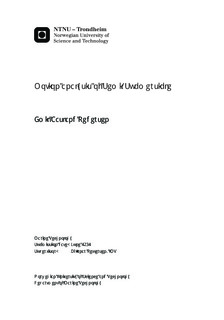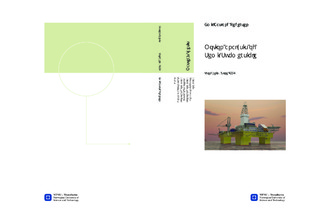| dc.description.abstract | In this thesis the response variables (RAOs) of a semi submersible unit are inspected. Both operational and survival condition as well as a shallow draft are inspected. The survival condition is inspected with respect to an element analysis. And both operational- and shallow draft condition are case studies, where the operational condition is inspected for two different damage cases. The unit in question is a four column semi submersible, based on the GG5000 design. This is a relatively new design, and the first vessel to get this design is in its final engineering stage. Construction start is planned to be in August this year (2012). This unit will get the name COSLProspector and will be built in CIMC Yantai Raffles shipyard in China.The unit is symmetrical about the centre line and close to symmetrical about the vertical transverse plane, only pontoon tips are different. Because of this, no significant simplifications have been necessary in order to simplify the calculation due to computational time. Another reason for not doing any simplifications to the geometry is due to the fact that the results are desired to be the most realistic. However, to reduce computational time, only half the unit has been modelled due to symmetry about centre line.To find the appropriate element size for the mesh, an element analysis has been carried out. The results from this analysis resulted in a chosen element size of 2.5m. This element size both gives accurate results, and requires a relatively short computational time. The units resonance periods has been investigated, and verified by help of hand calculations and comparison with RAOs done by Global Maritime (2011). However not all the values were identical to each other, but many factors can influence on that result. The GM value was not changed in this thesis, but was in Global Maritime (2011), in addition the additional damping was in this thesis taken as 3% of critical damping, while in Global Maritime (2011), Morrison elements were taken into account. These factors, and perhaps a few shortenings are assumed to be the reason for the small difference in the responses, they are however small differences for most of the periods.Two damage cases have been modelled by flooding two different water ballast tanks. These damages will give an angle of list for the unit. Damage case 1 gives an angle of list of 13.18o with a rotation of heel axis of 7o forward. Damage case 2 gives a list angle of 11.68o with a rotation of the heel axis of 39o forward. An earlier study like this one is done by Henriksen (2011), found in Grenland Groups internal archive. AQWA does not give out the tilt angles in damage cases as this is not the main purpose of this program. Therefore, the list angles for the different cases have been obtained from the report done by Henriksen (2011). However, AQWA will be used to obtain the RAOs for both cases, as well as confirm floating equilibrium in such conditions.It is assumed that the tanks are completely emptied for air, and that seawater is filling the entire volume. A table showing the different tanks flooded and its weight with seawater is shown in table 1.Unit Volume [m3] Sea water weight [MT]BWT ST-2 692.51 709.82BWT ST-8 616.83 632.25Table 1: Weight of water for flooded tanksWhen it comes to the RAOs in the damage cases, they are very hard to read. This is mainly due to the fact that the motions in these cases are highly dependent on each other due to coupled motions. Due to an angle of list, the unit is no longer symmetric. As a consequence of this a RAO for a specific degree of freedom can no longer be read like it is only this degree of freedom which is affecting the responses, but one or more of the other degrees of freedom are strongly influencing. This makes some of the peaks appear where not normally expected.It is also noticeable that the highest motions are encountered for damage case 1, which is natural because this case has the highest list angle. The resonance periods are lower in the damage cases compared to the normal operational condition, however not to a degree which is dangerously low. The lowest resonance period is still in heave.From the RAOs in the shallow draft case, it can be noticed that the highest responses in heave are encountered for the shallow condition (14.5m) compared to the survival condition (15.5m) and operational condition (17.5m), however only up to about 18s, where after that it has the smallest response, and the operational condition has the highest.In roll and pitch the trends are fairly similar. The graphs are a little uneven until the first cancellation period, and then the shallow draft gives a higher response until reaching the resonance period. In the resonance region, the operational condition has the highest response for both roll and pitch, same as for the heave.As a conclusion, the optimal approach in a situation where the unit is heavily tilted is to try to ballast the unit to an even keel. But of course risks of doing this are a possibility, such as slamming problems and the fact that the resonance periods will be shorter. | nb_NO |

